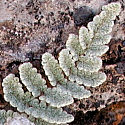 |
For photos
and descriptions
of desert fern species, see the IDENTIFICATION GUIDE |
 |
For photos
and descriptions
of desert fern species, see the IDENTIFICATION GUIDE |
Introduction
FERNS IN THE DESERT? Desert ferns are true xerophytes and have evolved several strategies to thrive in the warm, dry climate of the southwestern U.S. and northern Mexico. These small, elegant ferns are "resurrection plants" that curl up when dry and revive during rainy periods. They grow in rocky areas in desert grassland, oak woodland, Madrean evergreen woodland, and the transition zones between these plant communities. A few are found in saguaro desert upland.
ABOUT THIS GUIDE: This is a non-technical field guide that illustrates all xerophytic ferns found in Arizona. Most are endemic to Mexico and the southwestern U.S. Although a few are widespread, most are found only south of the Mogollon Rim and below about 8000 feet in elevation. Ferns in this guide were photographed in southern Arizona. Distribution of xerophytic ferns in northern Arizona can be found at NAZFlora.
Above 8000 feet, the ponderosa pine and douglas fir forests on the highest "sky island" mountain ranges contain an entirely different group of ferns, most of which are more common in the humid forests of the northeastern U.S. and Europe. They are described in many other fern guides and are not included here.DESERT FERNS ARE FRAGILE!! Their brittle stems and shallow roots make them especially vulnerable to trampling and erosion. Most have very specific requirements for substrate, moisture, and light that limit their distribution. Several are uncommon and/or restricted to certain microclimates within a small geographic range. Even within favorable habitats, areas that are protected from disturbance are small, rare, and often threatened.
COLLECTION IS DISCOURAGED, and in some localities it is prohibited by law. Collect notes and photos instead! A geologist's 10x hand lens is helpful for viewing tiny details. The descriptions in this guide include only those features that are easily observed in the field, but these are sufficient for identification. (For technical descriptions, authors of species, generalized range maps, and other formal botanical details, please see the Flora of North America: FERNS which was the taxonomic reference for this guide.)
GARDENING with xerophytic ferns is a challenge because of the highly specialized growing conditions that these species require. Ferns transplanted from the wild are unlikely to survive. The American Fern Society has an informative article on Cheilanthes cultivation HERE.
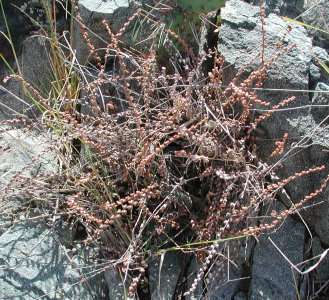
Astrolepis cochisensis ssp. arizonica
XEROPHYTIC FERNS are the "resurrection ferns". They have the ability to shrivel and go dormant for months. During this time, they curl up and look quite brown and dead. But they revive and turn green again when rain arrives. They begin life in rock fractures, beside boulders, under shrubs, or in other sheltered areas that provide a microclimate that is cooler, shadier, and more humid than the surrounding environment. Most species have additional adaptations that are very similar to those seen in flowering desert plants. These features are especially well-developed on the underside of the leaflet, which holds the spores and is often exposed to the sun when the plant is dry. Adaptations include:
Reduced Surface Area: These ferns are much smaller and less conspicuous than many humid-climate ferns. Leaves are small and sparse, and leaflets and/or segments are often rounded rather than elongate. Extreme examples include Astrolepis cochisensis, Argyrochosma limitanea, and Notholaena neglecta. Several Cheilanthes have tiny convex beadlike segments, which reduces evaporation and helps to shade the underside of the leaf.
Leathery Leaflets: Like many desert shrubs, Pellaea, Argyrochosma, and Notholaena have thickened, leathery leaflets that are often grayish or bluish green in color. This type of leaf helps protect the plant from drying out, especially during extreme hot and cold temperatures.
Thickened Leaf Margins: Fertile leaflets of Pellaea and Argyrochosma limitanea have the margins rolled under, and those of Cheilanthes have the margin thickened into a ridge that gives the genus its common name, Lip Fern. Notholaena leaf margins are folded under. All of these structures help to protect the spores. They also make the leaf more rigid when dry.
Waxy white coating: Argyrochosma, Notholaena, and Pentagramma triangularis have white or yellowish "farina" (tiny waxy or mealy grains) covering the underside of the leaflet to reflect light and protect the spores and leaf surface from losing water to evaporation. Notholaena also has scattered grains on the upper surface of the leaflets.
Hair or fuzz: Bommeria hispida and many Cheilanthes have soft hairs or feltlike fuzz on the leaflets and stem. Typically the hair is thicker and darker (tan or light brown) on the underside of the leaflet, and paler (white or pale tan), thinner, or even absent on the upper surface. The hairs shade the leaf surface and trap humid air, dew, and rainwater.
Scales: Flat translucent white, tan, or striped scales are present on the stems of many species. They are usually triangular, with long tapering points, and may have fringed margins. Several Cheilanthes also have overlapping scales along the veins on the underside of the leaflets. Two types of scales are the hallmark of Notholaena aschenborniana and the entire genus Astrolepis: the underside of the leaf has long, fringed, ribbonlike scales, and white star-shaped scales cover the upper surface. Like the cactus spines they resemble, these specialized scales reflect light and shade the leaflet.LEAFLETS: Examples of Adaptations in Xerophytic Ferns
tiny, rounded
Argyrochosmabeadlike
Cheilanthesleathery
Pellaeathickened margins
Cheilantheswaxy white coating
Notholaenafuzz
Cheilanthesscales: top
Astrolepisscales: underside
Cheilanthes
FERN ROCKS
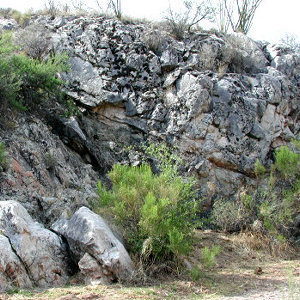 |
LIMESTONE
is a sedimentary rock composed of calcium carbonate (CaCO3).
It is usually very fine-grained (individual grains cannot be seen in the field) and is some shade of gray or bluish-gray. Limestone is slightly soluble in water, so the outcrop surface can be smooth and rounded, or weathered into tiny peaks and pits which are very rough and sharp. Irregular layers of yellowish or tan DOLOMITE (calcium magnesium carbonate) are found in some limestones but they are not as favorable to lime-loving ferns. MARBLE is metamorphosed limestone. In southern AZ both can be found together. Pure marble is white, with visible calcite crystals (the size of sugar crystals or larger), but small amounts of iron oxides may give the rock streaks of red, brown, or black. Most ferns that grow on limestone will also grow on marble. Limestone, marble, and dolomite are called carbonates or calcareous rocks. Ferns restricted to LIMESTONE: Astrolepis integerrima, Notholaena neglecta, N. aschenborniana, Argyrochosma jonesii, Cheilathes eatonii, C. feei. |
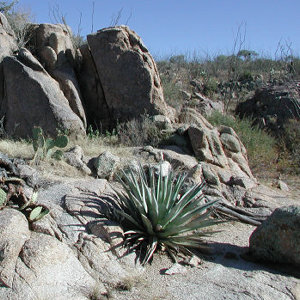 |
GRANITE
is an igneous rock made of quartz (colorless or transparent gray)
and feldspars (white, pink, or reddish), with a sprinkling of black iron-magnesium silicates (hornblende, biotite mica, etc.) and black oxides (primarily magnetite). It typically weathers into irregulaly rounded outcrops, rounded boulders, and picturesque rounded pinnacles, or tors. The surrounding soil is composed mostly of weathered feldspar crystals and small amounts of dark organic material. Ferns restricted to GRANITE: Pellaea truncata, Notholaena grayi, C. lendigera. |
| Some
ferns have no preference for specific rock types, though they still require
the shade, moisture, and protection that outcrops provide.
For some granite-loving ferns, rhyolite (the volcanic equivalent of granite) and intermediate volcanics such as andesite may be equally good substrates. For example, Cheilanthes lindheimeri is common on granite, but may also be found on rhyolite and even on argillaceous sedimentary rocks that are derived from felsic igneous rocks. C. bonariensis grows on rhyolite, andesite, and some granites. Argyrochosma incana is specific to rhyolite and does not grow on granite. Ferns that grow on MANY ROCK TYPES: Astrolepis sinuata, Argyrochosma limitanea, Bommeria hispida, Cheilanthes tomentosa, Notholaena standleyi. |
|
IDENTIFICATION
Most desert ferns are small (many have leaves only 10-15 cm long or less) and it is not unusual to find only one or two plants in a given area. Often several species will be found growing together, especially on shady north-facing slopes with plenty of rock outcrops. When you find an unfamiliar fern, note the following: substrate (rock type), exposure (sun, part shade, etc.), leaf shape & color, leaflet shape and arrangement (see diagram below), and the presence or absence of hairs, scales, and/or waxy coatings on the leaflets. Look carefully at the underside of the leaf, since this is often essential to identification. Use care when examining living ferns - they are extremely brittle.
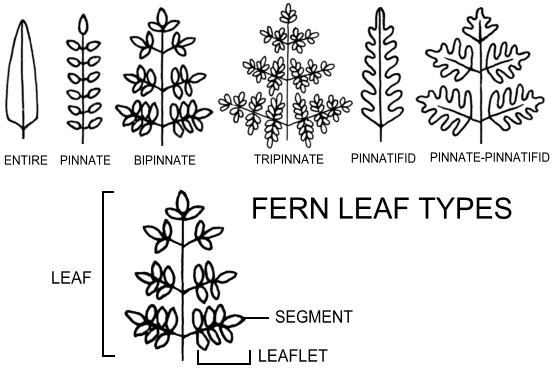
LINKS
PHOTOS:
Mexican xerophytic ferns in the Herbarium of George B. Hinton.
Southern
Arizona Botany HOME
Photos, text, and website
created and maintained by Lorena Babcock Moore. e-mail
PHOTOS: Online noncommercial
use is permitted with credit and a link to this page. Do not hotlink
to photos!
DRAWINGS are copyright 2007
by Lorena Babcock Moore.